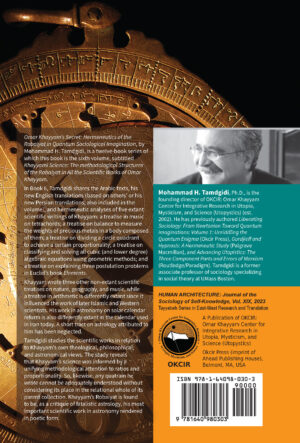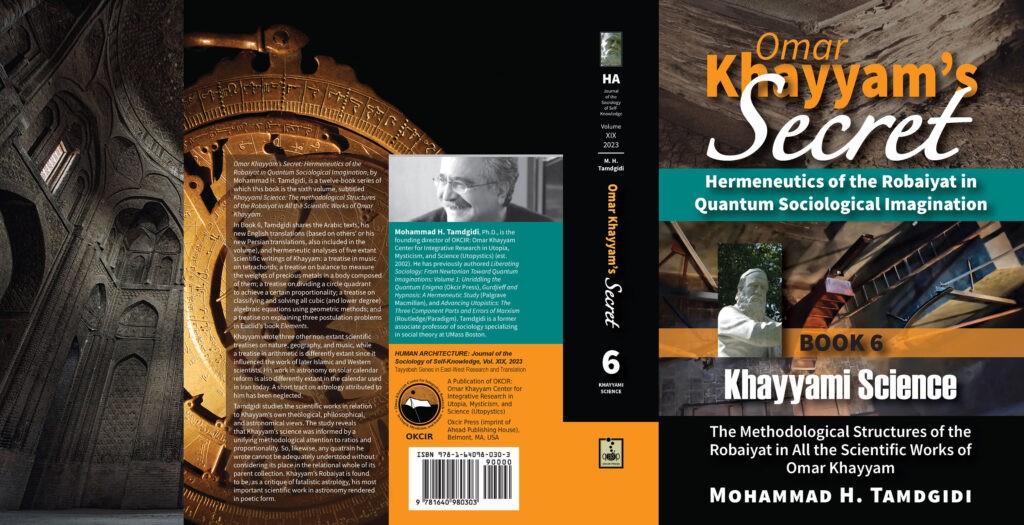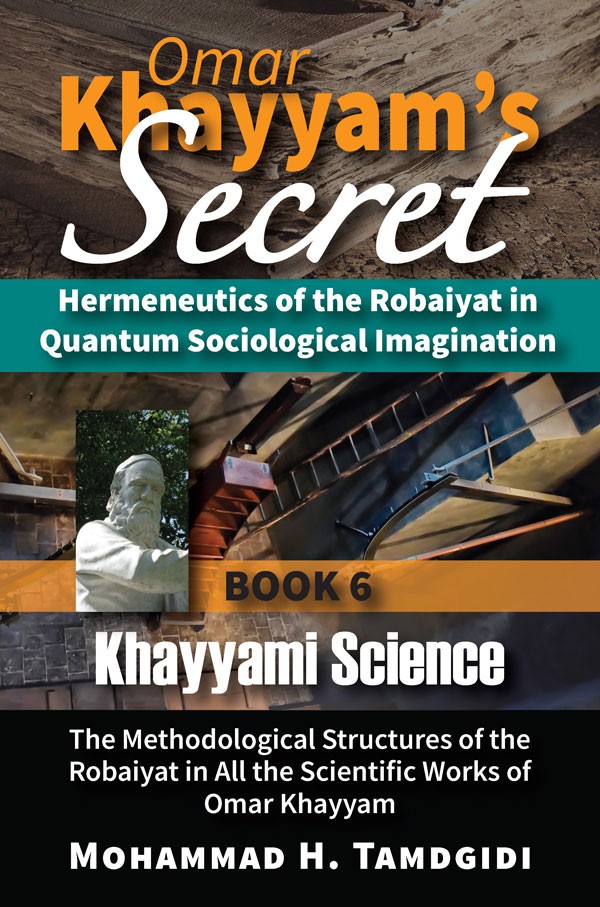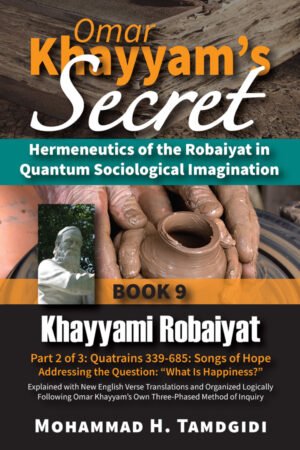Omar Khayyam’s Secret: Hermeneutics of the Robaiyat in Quantum Sociological Imagination: Book 6: Khayyami Science: The Methodological Structures of the Robaiyat in All the Scientific Works of Omar Khayyam
$69.99 – $119.00
Omar Khayyam’s Secret: Hermeneutics of the Robaiyat in Quantum Sociological Imagination, by Mohammad H. Tamdgidi, is a twelve-book series of which this book is the sixth volume, subtitled Khayyami Science: The Methodological Structures of the Robaiyat in All the Scientific Works of Omar Khayyam. Each book, independently readable, can be best understood as a part of the whole series. In this 6th of his Omar Khayyam’s Secret 12-book series, M. H. Tamdgidi offers the Arabic texts, his new English translations (based on others’ or his new Persian translations, also included in the volume), and hermeneutic analyses of five extant scientific writings of Khayyam.
Publication Date: June 10, 2023
Note: The ePub ebook edition of this title (ISBN: 9781640980327) can be purchased from major online ebook stores worldwide.

All the sections of this publication can be read online by logged-in members of the OKCIR Library with a valid access. In that case click on any section in the table of contents below, and then click on the large PDF icon at the bottom of that page to access the publication section. Alternatively, you can purchase this publication as offered below.
Description
Omar Khayyam’s Secret: Hermeneutics of the Robaiyat in Quantum Sociological Imagination
Book 6: Khayyami Science
The Methodological Structures of the Robaiyat in All the Scientific Works of Omar Khayyam
Author: Mohammad H. Tamdgidi
Publication Date: June 10, 2023
Human Architecture: Journal of the Sociology of Self-Knowledge (ISSN: 1540-5699)
Volume XIX, 2023, Monograph Series: Tayyebeh Series in East-West Research and Translation
Description
Omar Khayyam’s Secret: Hermeneutics of the Robaiyat in Quantum Sociological Imagination, by Mohammad H. Tamdgidi, is a twelve-book series of which this book is the sixth volume, subtitled Khayyami Science: The Methodological Structures of the Robaiyat in All the Scientific Works of Omar Khayyam. Each book, independently readable, can be best understood as a part of the whole series.
In Book 6, Tamdgidi shares the Arabic texts, his new English translations (based on others’ or his new Persian translations, also included in the volume), and hermeneutic analyses of five extant scientific writings of Khayyam: a treatise in music on tetrachords; a treatise on balance to measure the weights of precious metals in a body composed of them; a treatise on dividing a circle quadrant to achieve a certain proportionality; a treatise on classifying and solving all cubic (and lower degree) algebraic equations using geometric methods; and a treatise on explaining three postulation problems in Euclid’s book Elements. Khayyam wrote three other non-extant scientific treatises on nature, geography, and music, while a treatise in arithmetic is differently extant since it influenced the work of later Islamic and Western scientists. His work in astronomy on solar calendar reform is also differently extant in the calendar used in Iran today. A short tract on astrology attributed to him has been neglected.
Tamdgidi studies the scientific works in relation to Khayyam’s own theological, philosophical, and astronomical views. The study reveals that Khayyam’s science was informed by a unifying methodological attention to ratios and proportionality. So, likewise, any quatrain he wrote cannot be adequately understood without considering its place in the relational whole of its parent collection. Khayyam’s Robaiyat is found to be, as a critique of fatalistic astrology, his most important scientific work in astronomy rendered in poetic form.
Studying Khayyam’s scientific works in relation to those of other scientists out of the context of his own philosophical, theological, and astronomical views, would be like comparing the roundness of two fruits while ignoring that they are apples and oranges. Khayyam was a relational, holistic, and self-including objective thinker, being systems and causal-chains discerning, creative, transdisciplinary, transcultural, and applied in method. He applied a poetic geometric imagination to solving algebraic problems and his logically methodical thinking did not spare even Euclid of criticism. His treatise on Euclid unified numerical and magnitudinal notions of ratio and proportionality by way of broadening the notion of number to include both rational and irrational numbers, transcending its Greek atomistic tradition.
Khayyam’s classification of algebraic equations, being capped at cubic types, tells of his applied scientific intentions that can be interpreted, in the context of his own Islamic philosophy and theology, as an effort in building an algebraic and numerical theory of everything that is not only symbolic of body’s three dimensions, but also of the three-foldness of intellect, soul, and body as essential types of a unitary substance created by God to evolve relatively on its own in a two-fold succession order of coming from and going to its Source. Although the succession order poses limits, as captured in the astrological imagination, existence is not fatalistic. Khayyam’s conceptualist view of the human subject as an objective creative force in a participatory universe allows for the possibility of human self-determination and freedom depending on his or her self-awakening, a cause for which the Robaiyat was intended. Its collection would be a balanced unity of wisdom gems ascending from multiplicity toward unity using Wine and various astrological, geometrical, numerical, calendrical, and musical tropes in relationally classified quatrains that follow a logical succession order.
About the Author
Mohammad H. Tamdgidi, Ph.D., is the founding director and editor of OKCIR: Omar Khayyam Center for Integrative Research in Utopia, Mysticism, and Science (Utopystics) and its journal, Human Architecture: Journal of the Sociology of Self-Knowledge (ISSN: 1540-5699), which have served since 2002 to frame his independent research, pedagogical, and publishing initiatives. He is a former associate professor of sociology specializing in social theory at UMass Boston and has taught sociology at SUNY-Binghamton and SUNY-Oneonta.
Besides his currently in progress work published in the 12-book series Omar Khayyam’s Secret: Hermeneutics of the Robaiyat in Quantum Sociological Imagination (Okcir Press), Tamdgidi has previously authored Liberating Sociology: From Newtonian Toward Quantum Imaginations: Volume 1: Unriddling the Quantum Enigma (2020, Okcir Press), Gurdjieff and Hypnosis: A Hermeneutic Study (2009, Palgrave Macmillan), and Advancing Utopistics: The Three Component Parts and Errors of Marxism (2007, Routledge/Paradigm). He has published numerous peer reviewed articles and chapters and edited more than thirty journal issues.
Tamdgidi holds a Ph.D. and M.A. in sociology in conjunction with a graduate certificate in Middle Eastern studies from Binghamton University (SUNY). He received his B.A. in architecture from U.C. Berkeley, following enrollment as an undergraduate student of civil engineering in the Technical College of the University of Tehran, Iran.
His areas of scholarly and practical interest are the sociology of self-knowledge, human architecture, and utopystics-three fields of inquiry he invented in his doctoral studies and has since pursued as respectively intertwined theoretical, methodological and applied fields of inquiry altogether contributing to what he calls the quantum sociological imagination. His research, teaching, and publications have been framed by an interest in understanding how world-historical social structures and personal selves constitute one another. This line of inquiry has itself been a result of his longstanding interest in understanding the underlying causes of failures of the world’s utopian, mystical, and scientific movements in bringing about a just global society.

Omar Khayyam’s Secret: Hermeneutics of the Robaiyat in Quantum Sociological Imagination: Book 6: Khayyami Science: The Methodological Structures of the Robaiyat in All the Scientific Works of Omar Khayyam
Published by: Okcir Press (an imprint of Ahead Publishing House) • Belmont, Massachusetts
First Edition: June 10, 2023, published on the ninth centennial of Omar Khayyam’s passing (AD 1123)
800 pages • 6×9 inches • Includes figures, references, and index
Library of Congress Control Number (LCCN): 2023907731
ISBN: 13: 9781640980303 (hard cover with dust jacket: alk. paper)
ISBN: 9781640980310 (soft cover: alk. paper)
ISBN: 9781640980327 (ePub ebook)
ISBN: 9781640980334 (PDF ebook)
CITATION: Tamdgidi, Mohammad H. 2023. Omar Khayyam’s Secret: Hermeneutics of the Robaiyat in Quantum Sociological Imagination: Book 6: Khayyami Science: The Methodological Structures of the Robaiyat in All the Scientific Works of Omar Khayyam. (Human Architecture: Journal of the Sociology of Self-Knowledge: Vol. XIX, 2023. Tayyebeh Series in East-West Research and Translation.) Belmont, MA: Okcir Press.
Where to Purchase this Book: The various editions of this volume can be ordered from the Okcir Store and all major online bookstores worldwide (such as Amazon, Barnes&Noble, Google Play, and others).

Table of Contents
Omar Khayyam’s Secret: Hermeneutics of the Robaiyat in Quantum Sociological Imagination: Book 6: Khayyami Science: The Methodological Structures of the Robaiyat in All the Scientific Works of Omar Khayyam
Published to Date in the Series—ii
About the Author—viii
Acknowledgments—xix
Preface to Book 6: Recap from Prior Books of the Series—1
Introduction to Book 6: Exploring the Methodology of the Robaiyat in Omar Khayyam’s Scientific Works—9
1. Introduction—19
2. The Arabic Manuscript of Omar Khayyam’s Treatise in Music on Tetrachords—25
3. New Persian Translation of Omar Khayyam’s Treatise in Music on Tetrachords—28
4. New English Translation of Omar Khayyam’s Treatise in Music on Tetrachords—36
5. Textual Analysis of Omar Khayyam’s Treatise in Music on Tetrachords—44
6. Conclusion—58
1. Introduction—61
2. The Arabic Manuscript of Omar Khayyam’s Two Treatises, One on Using a Water Balance to Measure the Weight of Gold and Silver in a Body Composed of Them, and Another on the Straight Balance—76
3. Persian Translation of Omar Khayyam’s Two Treatises, One on Using a Water Balance to Measure the Weight of Gold and Silver in a Body Composed of Them, and Another on the Straight Balance—81
4. New English Translation of Omar Khayyam’s Two Treatises, One on Using a Water Balance to Measure the Weight of Gold and Silver in a Body Composed of Them, and Another on the Straight Balance—89
5. Textual Analysis of Omar Khayyam’s Two Treatises, One on Using a Water Balance to Measure the Weight of Gold and Silver in a Body Composed of Them, and Another on the Straight Balance—101
6. Conclusion—115
1. Introduction—119
2. The Arabic Manuscript of Omar Khayyam’s Treatise on Dividing A Circle Quadrant—126
3. The Persian Translation by Gholamhossein Mosaheb of Omar Khayyam’s Treatise on Dividing A Circle Quadrant—138
4. New English Translation of Omar Khayyam’s Treatise on Dividing A Circle Quadrant—153
5. Textual Analysis of Omar Khayyam’s Treatise on Dividing A Circle Quadrant—172
6. Conclusion—199
1. Introduction—203
2. The Arabic Manuscript of Omar Khayyam’s Treatise on the Proofs of Problems in Algebra and Equations—210
3. The Persian Translation by Gholamhossein Mosaheb of Omar Khayyam’s Treatise on the Proofs of Problems in Algebra and Equations—241
4. New English Translation of Omar Khayyam’s Treatise on the Proofs of Problems in Algebra and Equations—286
5. Textual Analysis of Omar Khayyam’s Treatise on the Proofs of Problems in Algebra and Equations—348
- A. The Mysterious Abu Taher—350
- B. When Did Khayyam Write His Treatise in Algebra?—361
- C. Puzzling Editorial Practices—369
- D. Significance of Khayyam’s Prayer Statements—380
- E. Khayyam’s Geometric Method of Solving Algebraic Equations—388
- F. The Poetry of Khayyam’s Geometric Method of Solving Algebraic Equations—400
- G. Reading Khayyam’s Treatise in Algebra in the Context of His Theological and Philosophical Writings—408
- H. Reading Khayyam’s Treatise in Algebra as His Algebraic Theory of Everything—426
6. Conclusion—431
1. Introduction—439
2. The Arabic Manuscript of Omar Khayyam’s Treatise on the Explanation of Postulation Problems in Euclid’s Work—453
3. The Persian Translation by Jalaleddin Homaei of Omar Khayyam’s Treatise on the Explanation of Postulation Problems in Euclid’s Work—480
4. New English Translation of Omar Khayyam’s Treatise on the Explanation of Postulation Problems in Euclid’s Work—518
5. Textual Analysis of Omar Khayyam’s Treatise on the Explanation of Postulation Problems in Euclid’s Work—570
- A. Matters of Existence of Khayyam’s Treatise on Euclid—570
- B. General Considerations Regarding Khayyam’s Treatise on Euclid—576
- C. Analyzing the First Book of Khayyam’s Treatise on Euclid—583
- D. Analyzing the Second Book of Khayyam’s Treatise on Euclid—595
- E. Analyzing the Third Book of Khayyam’s Treatise on Euclid—602
- F. Why Did Khayyam Write His Treatise on Euclid?—606
6. Conclusion—613
1. Introduction—623
2. Khayyam’s Other Scientific Treatises on Nature, Geography, Music, and Arithmetic—625
3. Khayyam, the Isfahan Observatory, Iran’s Solar Calendar Reform, Astronomy, and Astrology—633
4. Revisiting Nezami Arouzi’s Comments on Omar Khayyam’s Opinion of Astrology—648
5. Understanding the Scientific Works of Omar Khayyam Integratively—657
6. The Robaiyat As a Critique of Fatalistic Astrology—667
7. Conclusion—670
Conclusion to Book 6: Summary of Findings—677
Appendix: Transliteration System and Glossary—717
Cumulative Glossary of Transliterations (Books 1-5)—730
Book 6 Index—751








